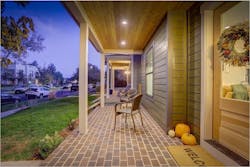Denver is a strong market for natural gas, which most homes use for heat and hot water. Despite this, some builders predict a shift in coming years to all-electric homes, and are trying to get ahead of that trend.
One is David Schultz, president of L&D Construction, which builds custom homes and accessory dwelling units (ADUs) in the urban center. He says that stricter code requirements, along with better heating and cooling technology, are making electric homes more attractive.
Xcel Energy, the utility that supplies the city with electricity and gas, seems to agree. L&D recently completed the first all-electric single-family Colorado home to be certified by the utility's New Homes Program.
RELATED
Why Electric?
One thing that could bolster the growth of all-electric homes is decarbonization. As electric power generation moves away from fossil fuels, a greater percentage of power will come from wind, solar, hydro, and nuclear. That will give all-electric homes a lower carbon footprint.
But while buyers care about environmental issues, a bigger purchase motivator is health. The double whammy of COVID-19–related lockdowns and wildfire smoke has led people everywhere—and especially in the West—to prefer homes that shield their family from health threats.
Electricity has an edge here. That's because even when a gas flame burns cleanly it still puts carbon dioxide and nitrous oxide into the air. And even if it has a sealed combustion furnace (which most new homes do), the gas range and water heater still generate these pollutants. Eliminating gas eliminates the worry.
Performance by Design
Of course, a lot of builders see electricity's higher cost-per-Btu compared with gas as an obstacle, but Schultz insists that's not a problem with a super-efficient heat pump. (He installs Mitsubishi units.)"With today's heat pump technology, electric heat doesn't have to cost more than gas," he says, adding that a properly equipped 3,000 square foot all-electric home should have an electric bill in the coldest months of just$200 to $250. That home also provides a hedge against future price gas shocks.
As an added bonus, rooftop solar panels make it possible for homeowners to “sell back” more power to the electricity company than they buy each year, a process called net metering. And when paired with a home battery (from a company like Panasonic, Tesla, or Sonnen) the panels will power the home day and night during an outage.
Getting these benefits requires a high-performance building envelope with minimal heating and cooling loads. "To be cost-effective, an all-electric house requires an exceptionally efficient envelope," says Schultz. Because most heat is lost through air leakage, walls, roofs and floors must be essentially draft-free.
That's not as hard as it sounds, and the extra cost is minimal. Energy codes already require a blower door test to certify an air leakage rate of no more than 3 air changes per hour at a 50 Pascal test pressure, or 3ACH50. Schultz gets results below 1ACH50 by putting a bit more care into caulking and sealing.
He also outfits every home with an energy recovery ventilator, or ERV, which constantly replaces stale indoor air with filtered outdoor air. The ERV makes an energy-efficient, all-electric home one of the healthiest possible.
Training and Incentives
Some builders doubt that they have the knowledge needed to build an efficient home that's trouble-free and has sufficient ventilation. Schultz suggests free online resources like those published by Building Science Corp., as well as paid seminars offered by organizations like the Energy and Environmental Building Alliance.
To encourage builders to up their game, Xcel Energy pays those in its program a cash incentive for every home that's more efficient than the local energy code. The less energy the home uses, the higher the incentive.
According to Rob Buchanan, Xcel Energy's Product Portfolio Manager, builders receive a baseline cash incentive for each home that exceeds the requirements set by the state energy code by 10%. The incentive then increases for every 5% improvement, with the maximum paid to homes that exceed code by 40%. Energy use is calculated from the home plans using RESNET-approved modeling software.
That's money the builder can invest in some building science education.

